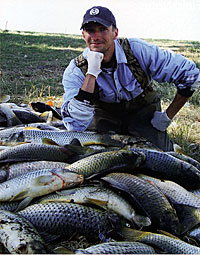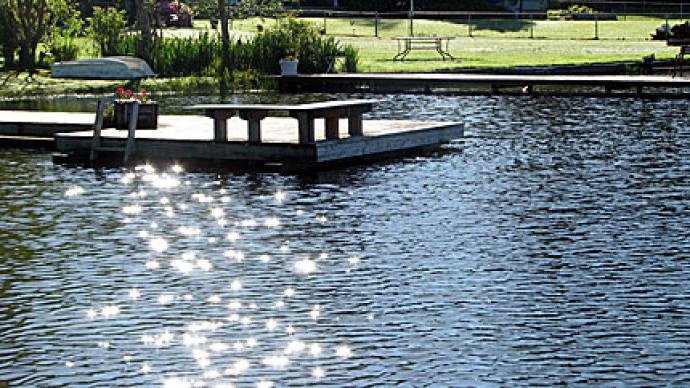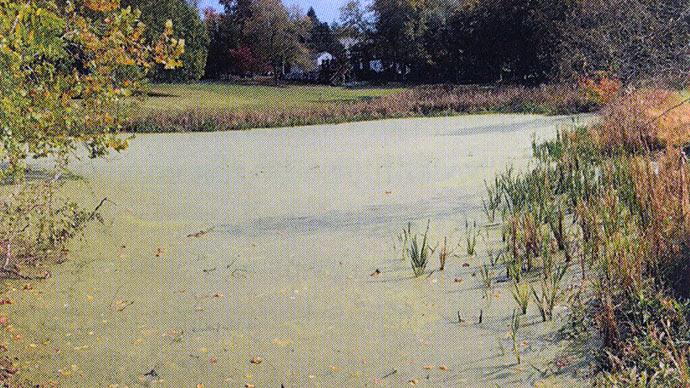
It's the last straw. You've tried everything, but the best alternative seems to be to remove your fish community and start over. The material most likely to be used for your renovation is rotenone. Eliminating the entire fish community is a drastic technique indeed! But, sometimes it is definitely the best choice. In this issue's column, we'll talk in general about this chemical and then provide a case history where we recently had an opportunity to use it.
Rotenone is a chemical lethal to fishes. Also called "derris" or "cube," rotenone has an interesting history. It truly is one of those "Medicine Man" type tales. Do you remember that 1992 Sean Connery movie? The remote jungles of the world contain many plants that have valuable uses–enter rotenone. It occurs naturally in the roots and stems of several tropical plants of the bean family from Southeast Asia as well as Central and South America. When roots of these plants are crushed, rotenone is released. Indigenous peoples from these areas have known this for centuries. They would crush the roots, and toss them into the water. Voila! Stunned or dying fish would float to the surface. Incidentally, these peoples have also long known of the ability of rotenone to kill insects. Rotenone has been used as a garden dust to control nuisance insects and also as an insecticide for use on some livestock and pets, in addition to its effects on fish.
Rotenone is lethal to fish because it is quickly absorbed by the gills and ultimately causes fish to suffocate. Most fish have some resistance to rotenone at very low concentrations and different species of fish have different tolerance thresholds to rotenone. Salmon and trout are least resistant to rotenone. Fishes such as goldfish and bullheads, which can tolerate very low dissolved oxygen levels, are most tolerant. While fish might be revived by placing them in clean water as soon as they surface, they quickly get a lethal dose and it's hard to salvage very many fish.
Rotenone is a toxic substance and it should be used with caution. It has been found safe for humans when properly applied by certified personnel and according to all instructions on the label. Fish killed by rotenone are not recommended for human consumption. Livestock, pets, and other animals that use the water body can safely drink the water when treated at application limits on the label. However, swine have some sensitivity to rotenone and we recommend that it not be used where they can access the water.
Rotenone will degrade naturally within 2 days to 2 weeks of application. Sunlight and warm temperatures accelerate this breakdown. It can be chemically neutralized when necessary by adding potassium permanganate. However, be aware that this chemical, too, can be lethal to fish if used at too high a concentration. Most states require a license or certification to apply rotenone, so you should check with your state's natural resource agency when planning a treatment. Local pond management consulting companies will know the rules and have necessary licenses.
Rotenone has been used as a fish toxicant in North America since the mid- 1930s. It is often used to eliminate nuisance fish populations (like common carp) or as a tool to estimate the total number and weight of fish in a water body (termed "cove rotenone sampling"). A cove of a lake or impoundment can be blocked off using a net and rotenone applied to kill the fish in that cove. The entire community of all fish species in the lake is then estimated based on what is collected from the cove. Rotenone has been used in lakes and wetlands with abundant destructive carp populations. The mission there is to diminish the numbers of carp to adjust their populations to allow other, more desirable fish to thrive. A recent, highly publicized story from the northeastern U.S. documented the use of rotenone in several ponds when the non-native northern snakehead fish (a voracious predator) was discovered in them. Heck! Remember the "Creature from the Black Lagoon?" They finally got that creature with rotenone!
Because rotenone will also kill invertebrates you might be worried your zooplankton and insect community will also be wiped out- pretty much the base of the food chain in a pond. Typically these communities rebound quickly through rapid re-colonization. Zooplankton especially have such short generation times that they can be reestablished within several weeks.
To calculate the amount of rotenone to apply to a pond, you must first know the water volume. A common target concentration for a rotenone treatment is 3 parts per million (ppm). Liquid rotenone is commonly available as 5% active ingredient. One gallon of this liquid rotenone will treat one acre-foot of water at 3 ppm. One acre is 209 feet by 209 feet, or 43,560 square feet. One acre-foot is an acre of water 12 inches deep. Lowering the water level of a pond, if possible and practical, will require less chemical be used, saving some money. The approximate volume of water in a pond can be calculated by multiplying surface area (acreage) by average depth (feet). The surface area can be determined through aerial photographs or by mapping the shoreline with most modern GPS units. The average depth can be determined by taking depth measurements in several places in the pond and calculating an average. A simpler method, though not quite as accurate, is to find the maximum depth and divide by 2. Here's an example.
Let's say a pond is 5 acres in surface area and has an average depth of 4 feet. The volume is 5 acres x 4 feet = 20 acre-feet. We would need 20 gallons of rotenone (1 gallon per acre-foot of water) to achieve our target rate of 3 ppm.
If a pond is deep, perhaps more than 10 feet or so, then some of the rotenone should be pumped to the pond bottom. This is especially true if the pond thermally stratifies (has a thermocline that separate warm surface water from colder bottom water). The rotenone won't cross that temperature barrier between the two layers. The liquid chemical usually is diluted with water, and then dripped into the prop wash of a boat to ensure maximum mixing in the pond. In fact, staking a jon boat onto the pond shoreline and leaving the outboard in gear will mix a lot of water in the pond.
Rotenone is expensive, which is another reason to not do a renovation unless it is necessary. Costs can range from $50 to $80 per gallon. At $70 per gallon, the 5-acre pond above would cost $70 X 20 acre-feet = $1,400. Prices vary from year to year and depend on total amount purchased.
While most biologists use liquid rotenone, it also comes in powder form.
Rotenone treatments by the state conservation agencies are much less common today than in the past. After all, a biologist must first be certain that the problem being addressed will not simply re-occur after the rotenone treatment. Societal attitude changes about adding chemicals to our water bodies may also have contributed to decreased use. The mess from rotting fish corpses on the shore might be a slight public relations issue! In certain instances, though, rotenone is still used.
We recently had an opportunity to participate in the renovation of a small lake in north-central Nebraska. The 158-acre, shallow lake had an abundant common carp population. Carp, at least in high densities, can degrade water quality and denude aquatic vegetation. Thus, they can be detrimental to sport fish populations as well as waterfowl and shorebirds. This lake certainly had been affected by the carp, as it contained almost no submergent aquatic plants and the blue-green algae were abundant.
As part of an ongoing research project, we decided to remove the entire fish community. Three airboats were used to apply the liquid rotenone and one prop boat was used to distribute some powdered rotenone as well (by the way, don't use powdered rotenone without someone experienced in its use!). In addition, an amphibious vehicle equipped with a plant sprayer was used to get into the hard to reach backwater areas and cattails beds of the lake to ensure the chemical was distributed throughout.
We didn't want to leave any hiding spots for the fish we were trying to eliminate. Two small carp of opposite genders left alive could ruin an expensive operation!
The first small fish started surfacing within an hour of first adding the chemical. Toward the end of the day numerous adult carp were observed struggling at the surface.
The biggest part of our job came after the rotenone application. We needed to estimate the number of total weight of all fish species in the lake. We (meaning Jeff and his technicians) walked certain areas of the lake shoreline and counted every dead fish. These counts were then used to estimate how many fish were in the entire lake. We know that lakes have many fish living in them but it sure is impressive to see all of those fish at one time! By the third day we wondered if we should be on the "World's Dirtiest Jobs" television program as the fish definitely were getting ripe! All in all, we believe that the lake contained about 5,412 adult common carp and 2,658,249 fathead minnows. Plus, these are probably underestimates because many fish sink to the bottom and may not float in time to get counted!
It will be interesting to watch potential changes in the lake after the treatment. Will the water clear up and new aquatic vegetation sprout up next year? Only time will tell. However, we certainly hope so! Both the sport fishes and the waterfowl should benefit from increased amounts of submergent aquatic vegetation. Without the use of rotenone to remove the undesirable fish, we could never have attempted this project.
Reprinted with permission from Pond Boss Magazine



